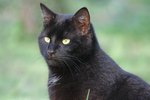Pet owners love their cats, there’s not doubt. Evidence of cats as pets dates back 8000 years, even before the Egyptians depicted cats in tomb wall paintings. But like the children we eventually turn them into, cats will put anything into their mouths that will fit--shoes, chair legs, the corners of picture frames and, most annoyingly, houseplants.
Chewing Plants
Veterinarians have no clear explanation as to why cats eat plants, but there are several common theories. Cats are omnivores, despite their well-earned reputations as predators, and need fiber in their diet. Outdoor cats obtain meager fiber from the intestinal contents of their prey. Grass and plant eating is thought to be a supplement to this. The acquisition of additional fiber may act as a method to help the cat eliminate hairballs from their digestive tract. Too much fiber is thought to act as an emetic, causing the cat to vomit up the hairball providing relief and reinforcing the plant eating behavior. But, the simplest explanation may be curiosity. Cats are curious creatures and plants, particularly newly introduced plants, bring with them new, enticing smells that warrant closer investigation.
Toxic vs. Nontoxic
None of the commonly propagated carnivorous plants is considered seriously toxic to cats. There have been some reports that nepenthes, or Asian pitcher plants, can cause mild digestive upset when ingested by cats, but no long-lasting or serious effects have been reported. The American Society for the Prevention of Cruelty to Animals maintains a list of plants that are considered by veterinarians to be toxic or nontoxic to cats.
Tasty Carnivorous Plants
Of the carnivorous plants grown in culture, sundews seem to be the ones cats most prefer to shred. Sundews, or drocera, compose one of the largest families of carnivorous plants. Their tentacles, used to capture hapless insects, are tipped with mucilage, a sticky exudate that often resembles freshly fallen morning dew, and seems irresistible to cats.
Plants Not Preferred
Sarracenias and Venus fly traps are known to have a sour taste and don’t seem to appeal to cats, given their disdain for sour-tasting things.
Preventative Measures
While not all plants are toxic to cats, chewing plants in general can be risky. Horticulture is a growing industry and with this growth has come the introduction of new plants imported from foreign countries for their unique and desirable qualities. Many of these plants have not been tested as to their toxicity, so caution is always a good idea when introducing new plants into a cat household. Some ways of dissuading cats from chewing plants is spraying the foliage with bitter apple, citrus or black pepper spray. Providing a substitute such as cat grass, available from pet stores, can keep your cat occupied and away from your houseplants.
References
Writer Bio
Kathy Imbriani's love of gardening grew from a childhood spent on the family farm. She is the co-author of two gardening books and numerous articles on science and gardening subjects. Imbriani holds a Bachelor of Science in horticulture from North Carolina State University.



